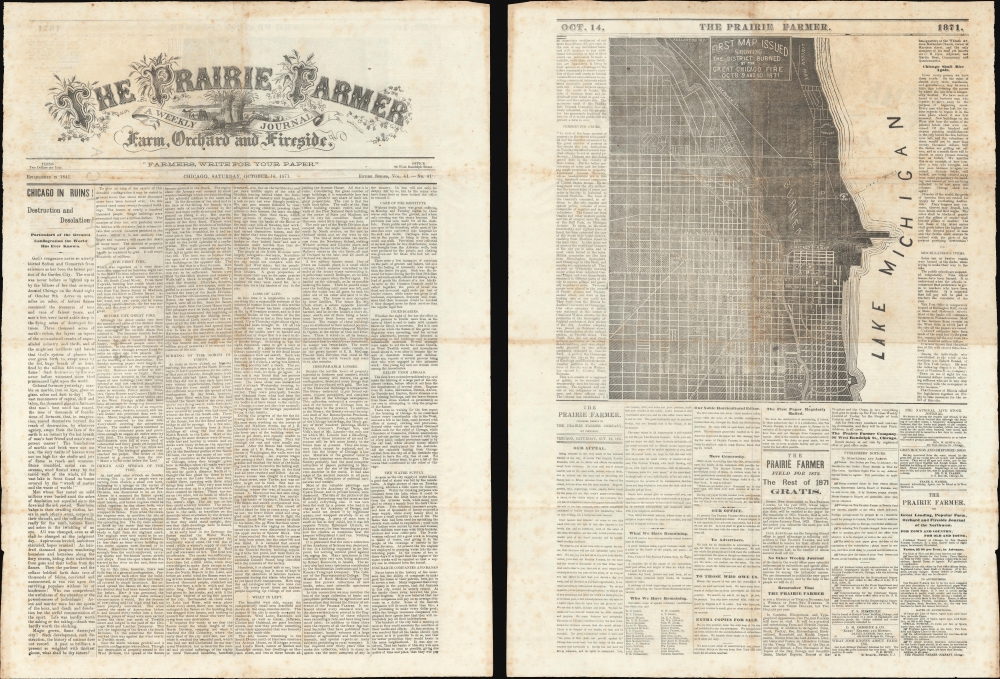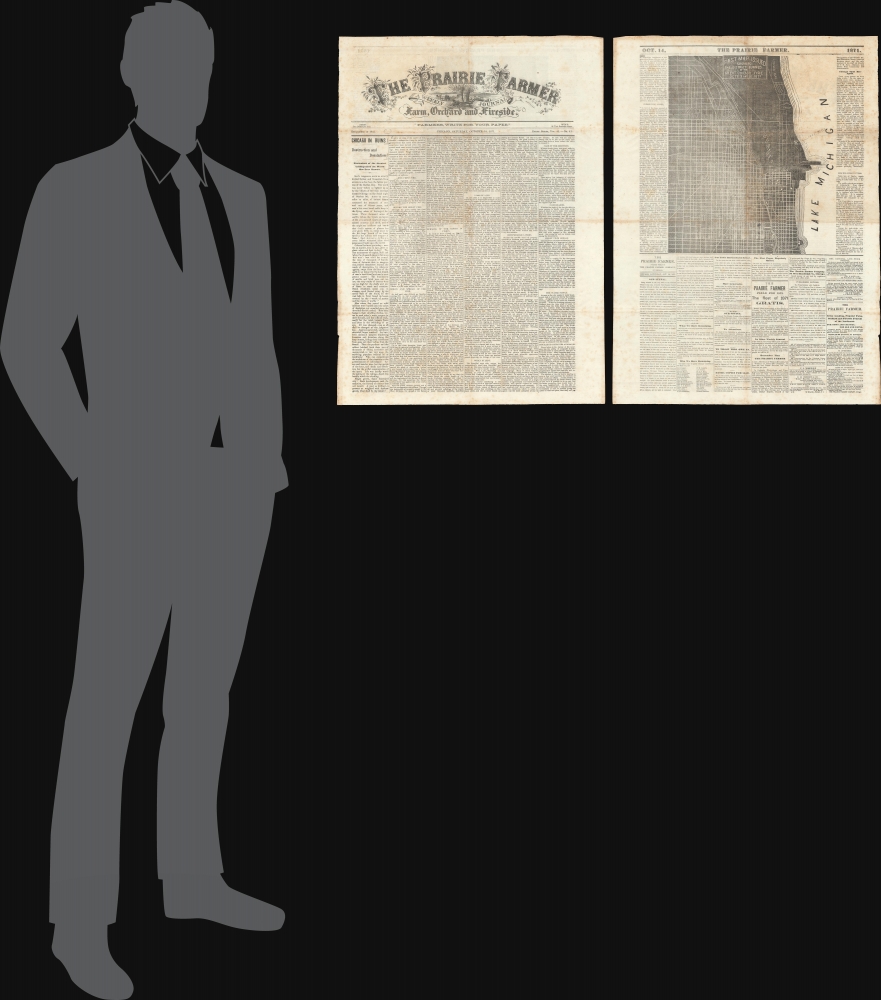1871 'Prairie Farmer' First Broadside Map of the Chicago Fire - issued days after fire!
ChicagoFire-prairiefarmer-1871
Title
1871 (dated) 22 x 16 in (55.88 x 40.64 cm)
Description
The Prairie Farmer
The Prairie Farmer was a weekly newspaper published in Chicago but marketed to rural farmers. Located at 112 Monroe Street, the Prairie Farmer's grandiose marble offices were immolated by the fire. Nonetheless, while fleeing the conflagration, editors saved subscription books, account books, a set of back issues, and some engravings. Despite the major catastrophe, the Prairie Farmer immediately re-established itself at more humble offices at 96 Randolph Street, and just days following the fire, this issue was mailed on time.The important map occupies roughly half of the broadside's verso. It is boldly titled 'First Map Issued Showing the District Burnt'. Although crudely engraved in woodcut, the map broadly embraces Chicago, roughly centered on the conjunction of the Chicago River with its North Branch. The burnt area is blacked out, with hachuring illustrating the limits of the fire.
As might be expected, the post-fire issue was much smaller than their usual multi-page issues, consisting of just a single broadside, printed back to back. It does, nonetheless, feature the first map illustrating the area devastated by the Great Chicago Fire. The front page begins with the dramatic headline, 'Chicago in Ruins!' and proceeds to elaborate on the devastation, underscoring the city-wide despair
God's vengeance never so utterly blotted Sodom and Gomorrah from existence as has been the fairest portion of the Garden City. The world was never before so lighted up as by the billows of fire that enwrapt doomed Chicago on the dread night of October 9. Acres on acres, miles on miles, of hottest flames consumed the treasures of ten and tens of the fairest years, and men's feet were laved ankle-deep in the flying ashes of destroyed fortunes. Three thousand acres of earth's riches, the layers on layers of the accumulated results of unparalleled industry and thrift, and of the mightiest intellects and hands that God's system of planets has ever given birth to, swept away by the hot, huge breath of an hour, fired by the million fold tongues of flame!The article breaks the fire into two separate related conflagrations. The first fire, it reports, started at
a beer saloon located at No. 195 South Canal Street. From there it spread, burning four entire blocks and four parts of blocks, embracing the territory from Van Buren Street to Madison, and from the River to Clinton Street.A second more violent fire began
At half past nine o'clock on Sunday evening, October 15 [this can only be a misprint], just as people were returning from church, a small cow barn, belonging to a cottage on the corner of DeKovan and Jefferson streets, in the West Division, was discovered to be on fire. Almost [sic] in a moment, the flames spread over a large number of sheds, barns, and small houses, and before engines could be called together by the alarm bells, very many buildings, on either side, were entrapped in flames.The above is no doubt the origin of the O'Leary Cow legend.
In addition to the map, the verso features a lengthy appeal to subscribers to renew in advance in exchange for four issues free. It also begs those with outstanding dues and advertising invoices to pay promptly. This section further features some advertising and a list of retained assets, including most of the paper's staff of editors and specialist reporters.
The Great Chicago Fire
The Great Chicago Fire burned roughly 3.3 square miles of Chicago, Illinois, from October 8 - 10, 1871. Although only about 300 people died, the fire consumed 17,000 buildings and left more than 100,000 residents homeless. Early Chicago's wooden construction and dry, windy conditions led to the fire's rapid spread. Although the cause of the fire was never determined, legends and theories spread quickly. The most popular was that Mrs. Catherine O'Leary was milking her cow in the family's De Koven Street barn when the cow kicked over a lantern (or an oil lamp, depending on the version of the story) that set the barn, and within minutes, the city, ablaze. The fire spurred extensive rebuilding efforts and led to stricter building codes, ultimately transforming Chicago into a modern, more resilient city. Slightly more than 20 years later, Chicago has been fully rebuilt and celebrated its achievement with the 1893 World's Columbian Exposition, arguably the most successful World's Fair.Publication History and Census
This newspaper was issued on October 14, 1871. It is rare. We note no record of it on the market. The issue is included in the digital archives of the University of Illinois, but it is unclear if they have a physical holding or if the scan archive was compiled from microfiche. Otherwise, this issue, likely a very limited and ephemeral run, is virtually unknown.Cartographer
Prairie Farmer (1841 - Present), published in Chicago, Illinois, is one of the oldest agricultural publications in the United States. Initially launched as The Union Agriculturist and Western Prairie Farmer by John Stephen Wright (1815 - 1874), it aimed to provide practical information and advocacy for Midwestern farmers. Over the decades, it grew in influence, offering a mix of farming techniques, industry news, and rural lifestyle content, adapting to the changing needs of its readership. Wright actively managed the newspaper until 1856, when he hired an editor and turned his business interests elsewhere. During the Great Chicago Fire of 1871, Prairie Farmer's offices in central Chicago were destroyed, but some printing tools, a subscriber list, and back issues were saved, allowing the editors to continue their operations and even meet publication deadlines for their next issue, just days after the event. The Prairie Farmer played a crucial role in advancing agricultural education and innovation, supporting the development of modern farming practices. Today, it continues to serve as a vital resource for the agricultural community, maintaining its legacy of support and information for farmers. More by this mapmaker...




